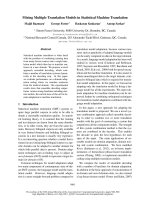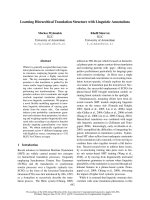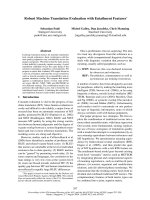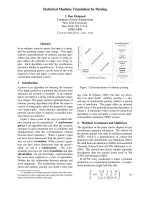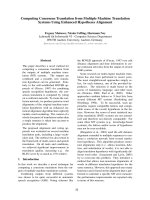Báo cáo khoa học: "Statistical Machine Translation with Word- and Sentence-Aligned Parallel Corpora" potx
Bạn đang xem bản rút gọn của tài liệu. Xem và tải ngay bản đầy đủ của tài liệu tại đây (126.17 KB, 8 trang )
Statistical Machine Translation with
Word- and Sentence-Aligned Parallel Corpora
Chris Callison-Burch David Talbot Miles Osborne
School on Informatics
University of Edinburgh
2 Buccleuch Place
Edinburgh, EH8 9LW
Abstract
The parameters of statistical translation models are
typically estimated from sentence-aligned parallel
corpora. We show that significant improvements in
the alignment and translation quality of such mod-
els can be achieved by additionally including word-
aligned data during training. Incorporating word-
level alignments into the parameter estimation of
the IBM models reduces alignment error rate and
increases the Bleu score when compared to training
the same models only on sentence-aligned data. On
the Verbmobil data set, we attain a 38% reduction
in the alignment error rate and a higher Bleu score
with half as many training examples. We discuss
how varying the ratio of word-aligned to sentence-
aligned data affects the expected performance gain.
1 Introduction
Machine translation systems based on probabilistic
translation models (Brown et al., 1993) are gener-
ally trained using sentence-aligned parallel corpora.
For many language pairs these exist in abundant
quantities. However for new domains or uncommon
language pairs extensive parallel corpora are often
hard to come by.
Two factors could increase the performance of
statistical machine translation for new language
pairs and domains: a reduction in the cost of cre-
ating new training data, and the development of
more efficient methods for exploiting existing train-
ing data. Approaches such as harvesting parallel
corpora from the web (Resnik and Smith, 2003)
address the creation of data. We take the second,
complementary approach. We address the prob-
lem of efficiently exploiting existing parallel cor-
pora by adding explicit word-level alignments be-
tween a number of the sentence pairs in the train-
ing corpus. We modify the standard parameter esti-
mation procedure for IBM Models and HMM vari-
ants so that they can exploit these additional word-
level alignments. Our approach uses both word- and
sentence-level alignments for training material.
In this paper we:
1. Describe how the parameter estimation frame-
work of Brown et al. (1993) can be adapted to
incorporate word-level alignments;
2. Report significant improvements in alignment
error rate and translation quality when training
on data with word-level alignments;
3. Demonstrate that the inclusion of word-level
alignments is more effective than using a bilin-
gual dictionary;
4. Show the importance of amplifying the contri-
bution of word-aligned data during parameter
estimation.
This paper shows that word-level alignments im-
prove the parameter estimates for translation mod-
els, which in turn results in improved statistical
translation for languages that do not have large
sentence-aligned parallel corpora.
2 Parameter Estimation Using
Sentence-Aligned Corpora
The task of statistical machine translation is to
choose the source sentence, e, that is the most prob-
able translation of a given sentence, f , in a for-
eign language. Rather than choosing e
∗
that di-
rectly maximizes p(e|f ), Brown et al. (1993) apply
Bayes’ rule and select the source sentence:
e
∗
= arg max
e
p(e)p(f |e). (1)
In this equation p(e) is a language model probabil-
ity and is p(f |e) a translation model probability. A
series of increasingly sophisticated translation mod-
els, referred to as the IBM Models, was defined in
Brown et al. (1993).
The translation model, p(f |e) defined as a
marginal probability obtained by summing over
word-level alignments, a, between the source and
target sentences:
p(f |e) =
a
p(f , a|e). (2)
While word-level alignments are a crucial com-
ponent of the IBM models, the model parame-
ters are generally estimated from sentence-aligned
parallel corpora without explicit word-level align-
ment information. The reason for this is that
word-aligned parallel corpora do not generally ex-
ist. Consequently, word level alignments are treated
as hidden variables. To estimate the values of
these hidden variables, the expectation maximiza-
tion (EM) framework for maximum likelihood esti-
mation from incomplete data is used (Dempster et
al., 1977).
The previous section describes how the trans-
lation probability of a given sentence pair is ob-
tained by summing over all alignments p(f |e) =
a
p(f , a|e). EM seeks to maximize the marginal
log likelihood, log p(f |e), indirectly by iteratively
maximizing a bound on this term known as the ex-
pected complete log likelihood, log p(f , a|e)
q(a)
,
1
log p(f |e) = log
a
p(f , a|e) (3)
= log
a
q(a)
p(f , a|e)
q(a)
(4)
≥
a
q(a) log
p(f , a|e)
q(a)
(5)
= log p(f , a|e)
q(a)
+ H(q (a))
where the bound in (5) is given by Jensen’s inequal-
ity. By choosing q(a) = p(a|f , e) this bound be-
comes an equality.
This maximization consists of two steps:
• E-step: calculate the posterior probability
under the current model of every permissi-
ble alignment for each sentence pair in the
sentence-aligned training corpus;
• M-step: maximize the expected log like-
lihood under this posterior distribution,
log p(f , a|e)
q(a)
, with respect to the model’s
parameters.
While in standard maximum likelihood estima-
tion events are counted directly to estimate param-
eter settings, in EM we effectively collect frac-
tional counts of events (here permissible alignments
weighted by their posterior probability), and use
these to iteratively update the parameters.
1
Here ·
q(·)
denotes an expectation with respect to q(·).
Since only some of the permissible alignments
make sense linguistically, we would like EM to use
the posterior alignment probabilities calculated in
the E-step to weight plausible alignments higher
than the large number of bogus alignments which
are included in the expected complete log likeli-
hood. This in turn should encourage the parame-
ter adjustments made in the M-step to converge to
linguistically plausible values.
Since the number of permissible alignments for
a sentence grows exponentially in the length of the
sentences for the later IBM Models, a large num-
ber of informative example sentence pairs are re-
quired to distinguish between plausible and implau-
sible alignments. Given sufficient data the distinc-
tion occurs because words which are mutual trans-
lations appear together more frequently in aligned
sentences in the corpus.
Given the high number of model parameters and
permissible alignments, however, huge amounts of
data will be required to estimate reasonable transla-
tion models from sentence-aligned data alone.
3 Parameter Estimation Using Word- and
Sentence-Aligned Corpora
As an alternative to collecting a huge amount of
sentence-aligned training data, by annotating some
of our sentence pairs with word-level alignments
we can explicitly provide information to highlight
plausible alignments and thereby help parameters
converge upon reasonable settings with less training
data.
Since word-alignments are inherent in the IBM
translation models it is straightforward to incorpo-
rate this information into the parameter estimation
procedure. For sentence pairs with explicit word-
level alignments marked, fractional counts over all
permissible alignments need not be collected. In-
stead, whole counts are collected for the single hand
annotated alignment for each sentence pair which
has been word-aligned. By doing this the expected
complete log likelihood collapses to a single term,
the complete log likelihood (p(f , a|e)), and the E-
step is circumvented.
The parameter estimation procedure now in-
volves maximizing the likelihood of data aligned
only at the sentence level and also of data aligned
at the word level. The mixed likelihood function,
M, combines the expected information contained
in the sentence-aligned data with the complete in-
formation contained in the word-aligned data.
M =
N
s
s=1
(1 − λ)log p(f
s
, a
s
|e
s
)
q(a
s
)
+
N
w
w=1
λ log p(f
w
, a
w
|e
w
) (6)
Here s and w index the N
s
sentence-aligned sen-
tences and N
w
word-aligned sentences in our cor-
pora respectively. Thus M combines the expected
complete log likelihood and the complete log likeli-
hood. In order to control the relative contributions
of the sentence-aligned and word-aligned data in
the parameter estimation procedure, we introduce a
mixing weight λ that can take values between 0 and
1.
3.1 The impact of word-level alignments
The impact of word-level alignments on parameter
estimation is closely tied to the structure of the IBM
Models. Since translation and word alignment pa-
rameters are shared between all sentences, the pos-
terior alignment probability of a source-target word
pair in the sentence-aligned section of the corpus
that were aligned in the word-aligned section will
tend to be relatively high.
In this way, the alignments from the word-aligned
data effectively percolate through to the sentence-
aligned data indirectly constraining the E-step of
EM.
3.2 Weighting the contribution of
word-aligned data
By incorporating λ, Equation 6 becomes an interpo-
lation of the expected complete log likelihood pro-
vided by the sentence-aligned data and the complete
log likelihood provided by word-aligned data.
The use of a weight to balance the contributions
of unlabeled and labeled data in maximum like-
lihood estimation was proposed by Nigam et al.
(2000). λ quantifies our relative confidence in the
expected statistics and observed statistics estimated
from the sentence- and word-aligned data respec-
tively.
Standard maximum likelihood estimation (MLE)
which weighs all training samples equally, corre-
sponds to an implicit value of lambda equal to the
proportion of word-aligned data in the whole of
the training set: λ =
N
w
N
w
+N
s
. However, having
the total amount of sentence-aligned data be much
larger than the amount of word-aligned data implies
a value of λ close to zero. This means that M can be
maximized while essentially ignoring the likelihood
of the word-aligned data. Since we believe that the
explicit word-alignment information will be highly
effective in distinguishing plausible alignments in
the corpus as a whole, we expect to see benefits by
setting λ to amplify the contribution of the word-
aligned data set particularly when this is a relatively
small portion of the corpus.
4 Experimental Design
To perform our experiments with word-level aligne-
ments we modified GIZA++, an existing and freely
available implementation of the IBM models and
HMM variants (Och and Ney, 2003). Our modifi-
cations involved circumventing the E-step for sen-
tences which had word-level alignments and incor-
porating these observed alignment statistics in the
M-step. The observed and expected statistics were
weighted accordingly by λ and (1 − λ) respectively
as were their contributions to the mixed log likeli-
hood.
In order to measure the accuracy of the predic-
tions that the statistical translation models make un-
der our various experimental settings, we choose
the alignment error rate (AER) metric, which is de-
fined in Och and Ney (2003). We also investigated
whether improved AER leads to improved transla-
tion quality. We used the alignments created during
our AER experiments as the input to a phrase-based
decoder. We translated a test set of 350 sentences,
and used the Bleu metric (Papineni et al., 2001) to
automatically evaluate machine translation quality.
We used the Verbmobil German-English parallel
corpus as a source of training data because it has
been used extensively in evaluating statistical trans-
lation and alignment accuracy. This data set comes
with a manually word-aligned set of 350 sentences
which we used as our test set.
Our experiments additionally required a very
large set of word-aligned sentence pairs to be in-
corporated in the training set. Since previous work
has shown that when training on the complete set
of 34,000 sentence pairs an alignment error rate as
low as 6% can be achieved for the Verbmobil data,
we automatically generated a set of alignments for
the entire training data set using the unmodified ver-
sion of GIZA++. We wanted to use automatic align-
ments in lieu of actual hand alignments so that we
would be able to perform experiments using large
data sets. We ran a pilot experiment to test whether
our automatic would produce similar results to man-
ual alignments.
We divided our manual word alignments into
training and test sets and compared the performance
of models trained on human aligned data against
models trained on automatically aligned data. A
Size of training corpus
Model .5k 2k 8k 16k
Model 1 29.64 24.66 22.64 21.68
HMM 18.74 15.63 12.39 12.04
Model 3 26.07 18.64 14.39 13.87
Model 4 20.59 16.05 12.63 12.17
Table 1: Alignment error rates for the various IBM
Models trained with sentence-aligned data
100-fold cross validation showed that manual and
automatic alignments produced AER results that
were similar to each other to within 0.1%.
2
Having satisfied ourselves that automatic align-
ment were a sufficient stand-in for manual align-
ments, we performed our main experiments which
fell into the following categories:
1. Verifying that the use of word-aligned data has
an impact on the quality of alignments pre-
dicted by the IBM Models, and comparing the
quality increase to that gained by using a bilin-
gual dictionary in the estimation stage.
2. Evaluating whether improved parameter esti-
mates of alignment quality lead to improved
translation quality.
3. Experimenting with how increasing the ratio of
word-aligned to sentence-aligned data affected
the performance.
4. Experimenting with our λ parameter which al-
lows us to weight the relative contributions
of the word-aligned and sentence-aligned data,
and relating it to the ratio experiments.
5. Showing that improvements to AER and trans-
lation quality held for another corpus.
5 Results
5.1 Improved alignment quality
As a staring point for comparison we trained
GIZA++ using four different sized portions of the
Verbmobil corpus. For each of those portions we
output the most probable alignments of the testing
data for Model 1, the HMM, Model 3, and Model
2
Note that we stripped out probable alignments from our
manually produced alignments. Probable alignments are large
blocks of words which the annotator was uncertain of how to
align. The many possible word-to-word translations implied by
the manual alignments led to lower results than with the auto-
matic alignments, which contained fewer word-to-word trans-
lation possibilities.
Size of training corpus
Model .5k 2k 8k 16k
Model 1 21.43 18.04 16.49 16.20
HMM 14.42 10.47 9.09 8.80
Model 3 20.56 13.25 10.82 10.51
Model 4 14.19 10.13 7.87 7.52
Table 2: Alignment error rates for the various IBM
Models trained with word-aligned data
4,
3
and evaluated their AERs. Table 1 gives align-
ment error rates when training on 500, 2000, 8000,
and 16000 sentence pairs from Verbmobil corpus
without using any word-aligned training data.
We obtained much better results when incorpo-
rating word-alignments with our mixed likelihood
function. Table 2 shows the results for the differ-
ent corpus sizes, when all of the sentence pairs have
been word-aligned. The best performing model in
the unmodified GIZA++ code was the HMM trained
on 16,000 sentence pairs, which had an alignment
error rate of 12.04%. In our modified code the
best performing model was Model 4 trained on
16,000 sentence pairs (where all the sentence pairs
are word-aligned) with an alignment error rate of
7.52%. The difference in the best performing mod-
els represents a 38% relative reduction in AER. In-
terestingly, we achieve a lower AER than the best
performing unmodified models using a corpus that
is one-eight the size of the sentence-aligned data.
Figure 1 show an example of the improved
alignments that are achieved when using the word
aligned data. The example alignments were held
out sentence pairs that were aligned after training on
500 sentence pairs. The alignments produced when
the training on word-aligned data are dramatically
better than when training on sentence-aligned data.
We contrasted these improvements with the im-
provements that are to be had from incorporating a
bilingual dictionary into the estimation process. For
this experiment we allowed a bilingual dictionary
to constrain which words can act as translations of
each other during the initial estimates of translation
probabilities (as described in Och and Ney (2003)).
As can be seen in Table 3, using a dictionary reduces
the AER when compared to using GIZA++ without
a dictionary, but not as dramatically as integrating
the word-alignments. We further tried combining a
dictionary with our word-alignments but found that
the dictionary results in only very minimal improve-
ments over using word-alignments alone.
3
We used the default training schemes for GIZA++, and left
model smoothing parameters at their default settings.
Then
assume
.
Dann
reserviere
ich
zwei
Einzelzimmer
I
will
reserve
two
single
,
nehme
rooms
,
I
ich
mal
an
.
(a) Sentence-aligned
Then
assume
.
Dann
reserviere
ich
zwei
Einzelzimmer
I
will
reserve
two
single
,
nehme
rooms
,
I
ich
mal
an
.
(b) Word-aligned
Then
assume
.
Dann
reserviere
ich
zwei
Einzelzimmer
I
will
reserve
two
single
,
nehme
rooms
,
I
ich
mal
an
.
(c) Reference
Figure 1: Example alignments using sentence-aligned training data (a), using word-aligned data (b), and a
reference manual alignment (c)
Size of training corpus
Model .5k 2k 8k 16k
Model 1 23.56 20.75 18.69 18.37
HMM 15.71 12.15 9.91 10.13
Model 3 22.11 16.93 13.78 12.33
Model 4 17.07 13.60 11.49 10.77
Table 3: The improved alignment error rates when
using a dictionary instead of word-aligned data to
constrain word translations
Sentence-aligned Word-aligned
Size AER Bleu AER Bleu
500 20.59 0.211 14.19 0.233
2000 16.05 0.247 10.13 0.260
8000 12.63 0.265 7.87 0.278
16000 12.17 0.270 7.52 0.282
Table 4: Improved AER leads to improved transla-
tion quality
5.2 Improved translation quality
The fact that using word-aligned data in estimat-
ing the parameters for machine translation leads to
better alignments is predictable. A more signifi-
cant result is whether it leads to improved transla-
tion quality. In order to test that our improved pa-
rameter estimates lead to better translation quality,
we used a state-of-the-art phrase-based decoder to
translate a held out set of German sentences into
English. The phrase-based decoder extracts phrases
from the word alignments produced by GIZA++,
and computes translation probabilities based on the
frequency of one phrase being aligned with another
(Koehn et al., 2003). We trained a language model
AER when when
Ratio λ = Standard MLE λ = .9
0.1 11.73 9.40
0.2 10.89 8.66
0.3 10.23 8.13
0.5 8.65 8.19
0.7 8.29 8.03
0.9 7.78 7.78
Table 5: The effect of weighting word-aligned data
more heavily that its proportion in the training data
(corpus size 16000 sentence pairs)
using the 34,000 English sentences from the train-
ing set.
Table 4 shows that using word-aligned data leads
to better translation quality than using sentence-
aligned data. Particularly, significantly less data is
needed to achieve a high Bleu score when using
word alignments. Training on a corpus of 8,000 sen-
tence pairs with word alignments results in a higher
Bleu score than when training on a corpus of 16,000
sentence pairs without word alignments.
5.3 Weighting the word-aligned data
We have seen that using training data consisting
of entirely word-aligned sentence pairs leads to
better alignment accuracy and translation quality.
However, because manually word-aligning sentence
pairs costs more than just using sentence-aligned
data, it is unlikely that we will ever want to label
an entire corpus. Instead we will likely have a rel-
atively small portion of the corpus word aligned.
We want to be sure that this small amount of data
labeled with word alignments does not get over-
whelmed by a larger amount of unlabeled data.
0.07
0.075
0.08
0.085
0.09
0.095
0.1
0.105
0.11
0.115
0.12
0.1 0.2 0.3 0.4 0.5 0.6 0.7 0.8 0.9 1
Alignment Error Rate
Lambda
20% word-aligned
50% word-aligned
70% word-aligned
100% word-aligned
Figure 2: The effect on AER of varying λ for a train-
ing corpus of 16K sentence pairs with various pro-
portions of word-alignments
Thus we introduced the λ weight into our mixed
likelihood function.
Table 5 compares the natural setting of λ (where
it is proportional to the amount of labeled data in the
corpus) to a value that amplifies the contribution of
the word-aligned data. Figure 2 shows a variety of
values for λ. It shows as λ increases AER decreases.
Placing nearly all the weight onto the word-aligned
data seems to be most effective.
4
Note this did not
vary the training data size – only the relative contri-
butions between sentence- and word-aligned train-
ing material.
5.4 Ratio of word- to sentence-aligned data
We also varied the ratio of word-aligned to
sentence-aligned data, and evaluated the AER and
Bleu scores, and assigned high value to λ (= 0.9).
Figure 3 shows how AER improves as more
word-aligned data is added. Each curve on the graph
represents a corpus size and shows its reduction in
error rate as more word-aligned data is added. For
example, the bottom curve shows the performance
of a corpus of 16,000 sentence pairs which starts
with an AER of just over 12% with no word-aligned
training data and decreases to an AER of 7.5% when
all 16,000 sentence pairs are word-aligned. This
curve essentially levels off after 30% of the data is
word-aligned. This shows that a small amount of
word-aligned data is very useful, and if we wanted
to achieve a low AER, we would only have to label
4,800 examples with their word alignments rather
than the entire corpus.
Figure 4 shows how the Bleu score improves as
more word-aligned data is added. This graph also
4
At λ = 1 (not shown in Figure 2) the data that is only
sentence-aligned is ignored, and the AER is therefore higher.
0.06
0.08
0.1
0.12
0.14
0.16
0.18
0.2
0.22
0 0.2 0.4 0.6 0.8 1
Alignment error rate
Ratio of word-aligned to sentence-aligned data
500 sentence pairs
2000 sentence pairs
8000 sentence pairs
16000 sentence pairs
Figure 3: The effect on AER of varying the ratio of
word-aligned to sentence-aligned data
0.2
0.21
0.22
0.23
0.24
0.25
0.26
0.27
0.28
0.29
0 0.2 0.4 0.6 0.8 1
Bleu Score
Ratio of word-aligned to sentence-aligned data
500 sentence pairs
2000 sentence pairs
8000 sentence pairs
16000 sentence pairs
Figure 4: The effect on Bleu of varying the ratio of
word-aligned to sentence-aligned data
reinforces the fact that a small amount of word-
aligned data is useful. A corpus of 8,000 sentence
pairs with only 800 of them labeled with word align-
ments achieves a higher Bleu score than a corpus of
16,000 sentence pairs with no word alignments.
5.5 Evaluation using a larger training corpus
We additionally tested whether incorporating word-
level alignments into the estimation improved re-
sults for a larger corpus. We repeated our experi-
ments using the Canadian Hansards French-English
parallel corpus. Figure 6 gives a summary of the im-
provements in AER and Bleu score for that corpus,
when testing on a held out set of 484 hand aligned
sentences.
On the whole, alignment error rates are higher
and Bleu scores are considerably lower for the
Hansards corpus. This is probably due to the dif-
ferences in the corpora. Whereas the Verbmobil
corpus has a small vocabulary (<10,000 per lan-
Sentence-aligned Word-aligned
Size AER Bleu AER Bleu
500 33.65 0.054 25.73 0.064
2000 25.97 0.087 18.57 0.100
8000 19.00 0.115 14.57 0.120
16000 16.59 0.126 13.55 0.128
Table 6: Summary results for AER and translation
quality experiments on Hansards data
guage), the Hansards has ten times that many vocab-
ulary items and has a much longer average sentence
length. This made it more difficult for us to create a
simulated set of hand alignments; we measured the
AER of our simulated alignments at 11.3% (which
compares to 6.5% for our simulated alignments for
the Verbmobil corpus).
Nevertheless, the trend of decreased AER and in-
creased Bleu score still holds. For each size of train-
ing corpus we tested we found better results using
the word-aligned data.
6 Related Work
Och and Ney (2003) is the most extensive analy-
sis to date of how many different factors contribute
towards improved alignments error rates, but the in-
clusion of word-alignments is not considered. Och
and Ney do not give any direct analysis of how
improved word alignments accuracy contributes to-
ward better translation quality as we do here.
Mihalcea and Pedersen (2003) described a shared
task where the goal was to achieve the best AER. A
number of different methods were tried, but none
of them used word-level alignments. Since the best
performing system used an unmodified version of
Giza++, we would expected that our modifed ver-
sion would show enhanced performance. Naturally
this would need to be tested in future work.
Melamed (1998) describes the process of manu-
ally creating a large set of word-level alignments of
sentences in a parallel text.
Nigam et al. (2000) described the use of weight
to balance the respective contributions of labeled
and unlabeled data to a mixed likelihood function.
Corduneanu (2002) provides a detailed discussion
of the instability of maximum likelhood solutions
estimated from a mixture of labeled and unlabeled
data.
7 Discussion and Future Work
In this paper we show with the appropriate modifi-
cation of EM significant improvement gains can be
had through labeling word alignments in a bilingual
corpus. Because of this significantly less data is re-
quired to achieve a low alignment error rate or high
Bleu score. This holds even when using noisy word
alignments such as our automatically created set.
One should take our research into account when
trying to efficiently create a statistical machine
translation system for a language pair for which a
parallel corpus is not available. Germann (2001)
describes the cost of building a Tamil-English paral-
lel corpus from scratch, and finds that using profes-
sional translations is prohibitively high. In our ex-
perience it is quicker to manually word-align trans-
lated sentence pairs than to translate a sentence, and
word-level alignment can be done by someone who
might not be fluent enough to produce translations.
It might therefore be possible to achieve a higher
performance at a fraction of the cost by hiring a non-
professional produce word-alignments after a lim-
ited set of sentences have been translated.
We plan to investigate whether it is feasible to
use active learning to select which examples will
be most useful when aligned at the word-level. Sec-
tion 5.4 shows that word-aligning a fraction of sen-
tence pairs in a training corpus, rather than the entire
training corpus can still yield most of the benefits
described in this paper. One would hope that by se-
lectively sampling which sentences are to be manu-
ally word-aligned we would achieve nearly the same
performance as word-aligning the entire corpus.
Acknowledgements
The authors would like to thank Franz Och, Her-
mann Ney, and Richard Zens for providing the
Verbmobil data, and Linear B for providing its
phrase-based decoder.
References
Peter Brown, Stephen Della Pietra, Vincent Della Pietra,
and Robert Mercer. 1993. The mathematics of ma-
chine translation: Parameter estimation. Computa-
tional Linguistics, 19(2):263–311, June.
Adrian Corduneanu. 2002. Stable mixing of complete
and incomplete information. Master’s thesis, Mas-
sachusetts Institute of Technology, February.
A. P. Dempster, N. M. Laird, and D. B. Rubin. 1977.
Maximum likelihood from incomplete data via the
EM algorithm. Journal of the Royal Statistical Soci-
ety, 39(1):1–38, Nov.
Ulrich Germann. 2001. Building a statistical machine
translation system from scratch: How much bang for
the buck can we expect? In ACL 2001 Workshop on
Data-Driven Machine Translation, Toulouse, France,
July 7.
Philipp Koehn, Franz Josef Och, and Daniel Marcu.
2003. Statistical phrase-based translation. In Pro-
ceedings of the HLT/NAACL.
I. Dan Melamed. 1998. Manual annotation of trans-
lational equivalence: The blinker project. Cognitive
Science Technical Report 98/07, University of Penn-
sylvania.
Rada Mihalcea and Ted Pedersen. 2003. An evaluation
exercise for word alignment. In Rada Mihalcea and
Ted Pedersen, editors, HLT-NAACL 2003 Workshop:
Building and Using Parallel Texts.
Kamal Nigam, Andrew K. McCallum, Sebastian Thrun,
and Tom M. Mitchell. 2000. Text classification from
labeled and unlabeled documents using EM. Machine
Learning, 39(2/3):103–134.
Franz Josef Och and Hermann Ney. 2003. A system-
atic comparison of various statistical alignment mod-
els. Computational Linguistics, 29(1):19–51, March.
Kishore Papineni, Salim Roukos, Todd Ward, and Wei-
Jing Zhu. 2001. Bleu: a method for automatic eval-
uation of machine translation. IBM Research Report
RC22176(W0109-022), IBM.
Philip Resnik and Noah Smith. 2003. The web as a par-
allel corpus. Computational Linguistics, 29(3):349–
380, September.


